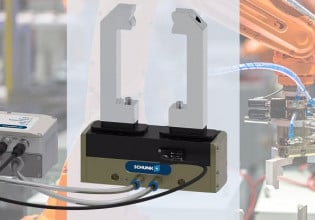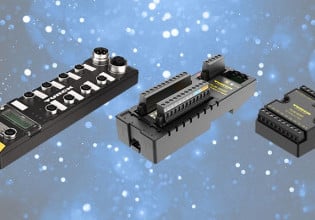Hydraulic Accumulators: What Are They and Why Do We Need Them?
Hydraulic systems suffer from pressure drops and energy loss whenever any fluid is in motion. Learn about these devices called ‘accumulators’. What are they, how do they work, and why do we need them?
You might be familiar with most hydraulic components, such as pumps, valves, motors, and actuators, but there is another very important component called an ‘accumulator’. As the name suggests, an accumulator is a vessel that stores, maintains, and recovers pressure.

Figure 1. A hydraulic accumulator located within a fluid system. Image used courtesy of Adobe Stock
What Is a Hydraulic Accumulator?
As we all know from middle school science class, as the amount of material filling a container’s volume reduces, the empty space needs to fill with air. In an accumulator, compressed gas is used to take up the empty space, but we don’t want the gas to mix with the hydraulic fluid, so there is typically a bladder inside the accumulator which separates the hydraulic fluid from the compressed gas.
Essentially, an accumulator is a vessel containing a bladder and gas so that as the bladder fills with pressurized hydraulic fluid, the gas compresses inside the vessel. When the fluid in the accumulator is released, the compressed gas pushes out the fluid.
The accumulator will come preloaded, which means a minimum pressure is required for fluid to flow into the accumulator. This preloading can be through springs, gas, or weights. There are bladder, piston, and diaphragm accumulators.
An accumulator can be compared to a battery or capacitor—it stores energy, but why would we want to store pressurized hydraulic fluid?

Figure 2. Cross-section view of an accumulator showing the flexible diaphragm and pressure chamber at the bottom (fluid entrance/exit valve port at the top). Image used courtesy of Wikimedia
Storing Pressurized Hydraulic Fluid
There are a few reasons for wanting to store pressurized hydraulic fluid, similar to reasons for storing electrical energy.
Reducing Pulsating Fluid Systems
One reason is systems that might have pulsations within the hydraulic fluid. I once worked on a machine that tested diesel fuel injectors. As the injector fired fluid, the pressurized fluid behind the injector would have a slight drop in pressure, similar to opening and closing a water tap very quickly. With the high speed of the injector, the sensors in the system would rattle and fluctuate their readings. With this being a testing machine, accuracy in pressure readings was very important, and the injectors needed a constant pressure source.
By adding an accumulator, the system no longer had to rely on the pump to make up for the pressure drop caused by the injector. The accumulator was able to replace the pressure lost by the injector fast enough that the sensor barely detected a change in pressure.
Compensating for Pressure Drop in Actuators
Similarly, a second reason that accumulators are important is for hydraulic motion control systems where the actuators are expanding at a very high speed. As the volume of the actuator expands, the pressure will drop in the system since the pump cannot supply an infinite flow rate. This leads to a reduced speed of the system response, which is unacceptable for many systems. The accumulator provides the flow capacity to keep the system pressure more constant, leading to a far more reliable system response.
Allowing for Thermal Expansion
Another reason is to allow for fluid expansion. Some hydraulic systems work in hazardous remote locations, which might get very hot, and the process of pressurizing hydraulic fluid also raises the temperature of the fluid. As the temperature rises, the volume of the fluid rises, and if there is no room in the system for the fluid to expand, the pressure in the system could cause a rupture.
Accumulators can be used to absorb this thermal expansion by allowing excess pressure to fill the accumulator. Once the temperature is reduced, the pressurized fluid can then be allowed back into the system from the accumulator.

Figure 3. Inside rendering of a noise suppressor to reduce shock and vibration noise using the same inert gas-filled chamber concept as a standard accumulator. Image used courtesy of Wilkes and McLean
Where Are Accumulators Located?
An accumulator's location can vary depending on the function of the accumulator. For example, an accumulator used for energy storage in the case of an emergency might be located out of the way of the rest of the system and only pressurized once. In the event of an emergency or the pump malfunctions, the accumulator can spring into action and help maintain pressure in the system.
In this same way, the common pressure tank inside a residential water system is a form of an accumulator, but rather than operating under emergency conditions, it simply allows the pump to operate on a less frequent cycle as opposed to continuously whenever water is demanded.
If you are trying to dampen pulsations and reduce noise from the pump, you might want to place the accumulator very close to the pump’s output. All the fluid would always flow through the accumulator dampening the vibrations produced by the pump. Because the accumulator stores energy, you will want to keep the accumulator on the high-pressure side of the system. A piston-style accumulator is best placed close to devices that cause pulsations to dampen those pulses.

Figure 4. Pressurized water storage tank with a charged gas chamber inside to maintain a consistent water pressure in a whole-house system. Image used courtesy of Adobe Stock
Hydraulic Accumulator Maintenance
Accumulators are basic devices with minimal moving parts, depending on the style of accumulator you have. Maintaining your accumulator can be dangerous and may require special third-party inspection—they are pressure vessels, just like compressed gas cylinders.
The different pre-charge methods introduce different maintenance procedures. The gas pre-charge accumulators might require checking and topping up the nitrogen gas. If an internal inspection is required or valves need to be replaced, the pre-charge gas will need to be vented and replaced. Always use inert gas as the pre-charge gas, never use oxygen or compressed air, and always follow the manufacturer-recommended maintenance schedule.
Accumulator in a Hydraulic System
A hydraulic control system directs the flow of fluid to different devices within the system. Most accumulators don’t require any input signals from the control system directly—the fluid is usually piped directly into and out of the accumulator. However, some systems might need to open a valve at the accumulator when required, so the control system must at least be aware of the presence of the accumulator.
Hydraulic Energy
Accumulators are devices that are great at storing hydraulic energy and dampening pulsations within the hydraulic system. Not all hydraulic systems will require an accumulator, but if your particular system is noisy or has vibrations, making it hard to read gauges and sensors, or if you need to maintain pressure while the pump is off, an accumulator might be able to help you out.






